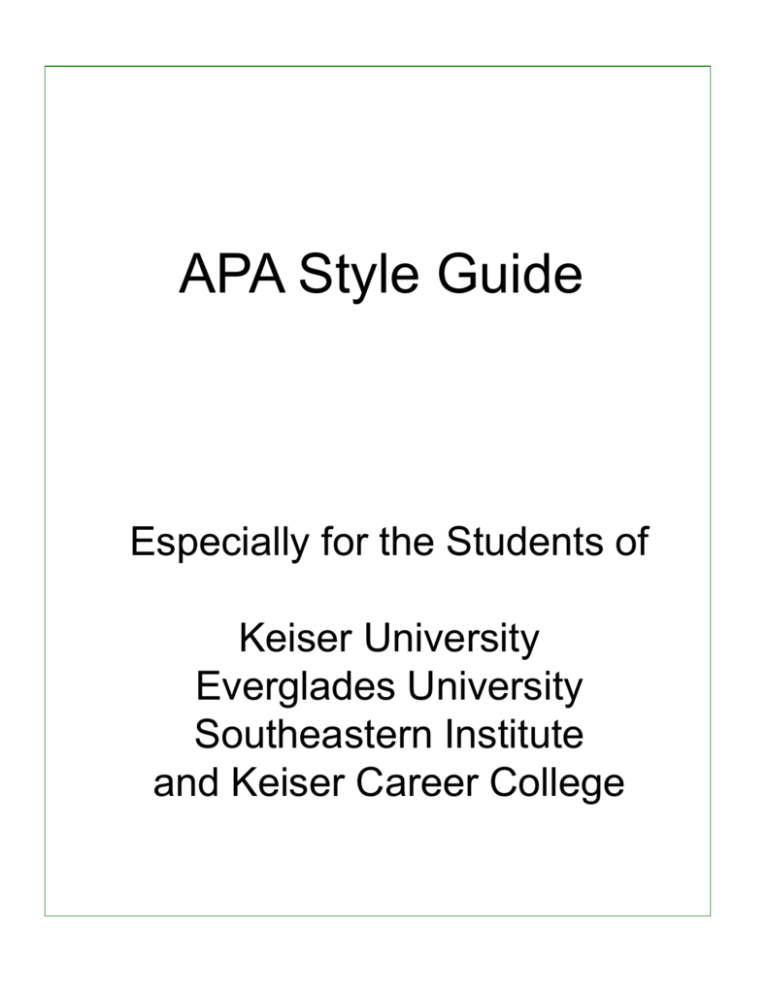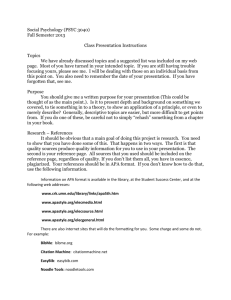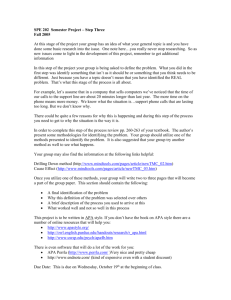APA Style Guide and Information Evaluation
advertisement

APA Style Guide Especially for the Students of Keiser University Everglades University Southeastern Institute and Keiser Career College This guide was created to make using APA style formats for college papers easy for students. You will find that this guide provides short, easy to understand explanations, as well as authoritative charts from the APA style experts. For best results, please view this tutorial in full screen mode, or print each slide on a page. To print only the pages you want to keep, please make a note of the slide numbers of those pages, and enter these as page numbers in the Print dialog box. Students, please note that your instructor may have special instructions for you. If there is a conflict between these standard instructions and your teacher’s instructions, please follow your teacher’s instructions. Student Guide to APA Style and Evaluating Information What is APA Style? The acronym “APA” stands for “American Psychological Association.” The APA is a professional membership organization, whose members work or have degrees in Psychology. Many years back, some leaders in this organization created a format for papers, so that they would be more readable. Their style caught on with nonpsychologists, too. Eventually, APA Style became widely used, especially in colleges and universities. APA Style is a format for writing papers. This format describes proper margins (one inch at the top, bottom, left, and right sides), the font size (12 points), the font types (Times New Roman or Arial fonts only), and the spacing (papers are double-spaced). In addition, there are formats for the title page (see example) and for the list of sources used for a paper (called “citations” or “references” or “reference list”). This handout provides examples, so that you will know what the standards are for papers at the university level. In case you feel you need extra help, here are links to the Writing Labs or Writing Centers of other universities. Help with APA Style for Citing References From the APA Style Web site and blog (URLs are below each entry) Sample papers http://search.apastyle.org/?query=&facet=stylecontenttype:Sample%20paper APA Style Blog – recommended for extra help http://blog.apastyle.org/apastyle/ Reference List FAQ (Frequently Asked Questions) http://search.apastyle.org/?query=&facet=styletopics:References (from Cornell University) http://www.library.cornell.edu/newhelp/res_strategy/citing/apa.html#apa (and from The Writing Center, University of Wisconsin) http://www.wisc.edu/writing/Handbook/DocAPA.html Recommended Web sites that will assist you in creating correct APA style Reference List citations: You put in the information for your sources, and this Web site creates your references in APA format, for you! Then, you just copy and paste into your paper. This takes more time, than simply typing the entries yourself, but while you are learning, this may be a good way to learn how to do it. Easy Bib http://www.easybib.com/ Son of Citation Machine – http://www.citationmachine.net/ Tips on How to Format the Entries in Your Reference List (from Cornell University http://www.library.cornell.edu/resrch/citmanage/apa) 1. Entries should be arranged in alphabetical order by authors' last names. Sources without authors are arranged alphabetically by title within the same list. 2. Write out the last name and initials for all authors of a particular work. Capitalize only the first word of a title or subtitle, and any proper names that are part of a title. 3. Use an ampersand (&) instead of the word "and" when listing multiple authors of a single work. 4. Use the abbreviation p. or pp. to designate page numbers of articles from periodicals that do not use volume numbers, especially newspapers. These abbreviations are also used to designate pages in encyclopedia articles and chapters from edited books. 5. Indentation *: The first line of the entry is flush with the left margin, and all subsequent lines are indented (5 to 7 spaces) to form a "hanging indent." 6. Underlining vs. Italics *: It is appropriate to use italics instead of underlining for titles of books and journals. Tips for Better Writing Style (Please use these!) (from Purdue University’s Online Writing Lab) http://owl.english.purdue.edu/ [also good for APA Style] (and from the Pennsylvania State University Writing Center) http://www.psu.edu/dept/cew/writingcenter/UWC/writingFAQ.htm How to Correctly Use Quotations (from the Purdue University Online Writing Lab) http://owl.english.purdue.edu/owl/resource/577/01/ ** How to Avoid Plagiarism (This is VERY important!) ** (Extra help from the Rice University Online Writing Lab) http://riceowl.rice.edu/guidance.cfm?doc_id=11767 Use these basic rules, to decide if you should give credit for an idea you are using in your paper: 1. Give credit for all ideas, whether you quote or whether you paraphrase the ideas into your own words. The ideas still belong to the person who thought them up – and published – whether you actually quote them, or not. If you use their idea, give them credit. 2. If you are even asking, “Should I give credit for this section or idea?” then you should give credit. 3. Here is a great and useful hint: If you create your Reference List of your sources BEFORE you type your paper, it is easier to type the parenthetical citations in your paper’s paragraphs as you type the paper, than it is to go back later and try to identify all of the ideas you used, and put in the parenthetical citations later. The bonus for doing it “backwards” like this, is that you will be far less likely to accidentally leave out a citation, and thus plagiarize someone else’s work in your paper. Plagiarizing means claiming someone else’s work or idea as your own, whether you intend to do it, or not! This is a very bad thing to do! So, be careful, don’t copy other people’s work – ever, and always give credit for the ideas you use in your papers, even when you paraphrase. An example Title Page may be found on the next page → Short Title of Your Paper (Note: these go in the Header part of your paper. In Word 2007, you set the header and page number by going into Page Number.) RUNNING HEAD: Shortened Title of Your Paper (Note: the RUNNING HEAD appears ONLY on your title page, and does not go on other pages.) Your Paper’s Full Title Your Name The Due Date or the Date You Turn in Your Paper The Name of Your Instructor The Name of the Course You are Taking 1 General Tips and Guidelines for Quoting and Paraphrasing (This was originally from the Pennsylvania State University Online Writing Center, but this page no longer exists.) YOUR OWN WORDS SHOULD CLEARLY DOMINATE. You are in control, not your sources. If you rely heavily on other people's words, then you are not writing the paper; they are. You need to paraphrase and summarize your sources as well as quote them. USE A VARIETY OF SOURCES. If you rely too much on one source, your reader may as well go directly to that source instead of reading your paper. Don't overuse any one source. CHOOSE YOUR QUOTATIONS CAREFULLY AND FOR SPECIFIC REASONS. Examples of reasons: * Later reference--You plan to discuss the quotation in some detail in your paper, and you feel that the reader needs to see the original in order to follow your discussion in all its complexity. * Memorable language--You think that the style of the source is so powerful, pithy, or elegant that you simply must let the reader hear the actual words. * Authority--You feel the need to bolster your argument by citing the words of an acknowledged authority in the field. (Remember that mere authority is not necessarily convincing; the argument itself must be convincing.) * Accuracy--You have tried several times to paraphrase the source but have been unable to do so adequately. (Remember that accurate paraphrasing helps you understand the source and that paraphrasing takes practice and always requires several drafts. Don't give up too quickly.) * Brevity--You have tried several times to paraphrase the source and each time have ended up with twice as many words as the original. (Again, since paraphrasing assures understanding and takes practice, play with the text for a while before surrendering to quotation.) CITE A SOURCE AND PAGE NUMBER FOR EACH QUOTATION. APA guidelines state that you must cite a source and page number for quotation but only a source for paraphrase. However, many professors also like to see a page number even for paraphrase; check with your professor to make sure. AVOID PLAGIARISM BY UNDERSTAND PARAPHRASING. Paraphrasing is more than substituting noun or verb synonyms; it involves changes in sentence structure. Paraphrasing is complex and requires practice; everyone finds it difficult at first. Your research process will be enhanced if you paraphrase your sources as you find them, and if you keep track of sources in an organized fashion. NOTE that rephrasing someone else’s ideas into your own words does not let you off the hook for giving them credit! Even if you paraphrase, you STILL must cite the source and give credit for the ideas! ALWAYS USE YOUR OWN WORDS BETWEEN QUOTATIONS. The reader needs to know how you are connecting the ideas, so you need to provide your own link between quotations. Never use quotations back to back without your own linking words. DISCUSS YOUR QUOTATIONS. Don't just pop in a quotation and run. Along with introducing the quotation so that the reader knows its relevance to your text, you often need to discuss the quotation's significance. Also, the longer the quotation, the more likely you need double the number of your own words to discuss it. The only time you need not discuss a quotation is when it is used as an epigraph (i.e., a quotation that appears right under the title at the beginning of a paper) because an epigraph's relevance is thematic to the entire paper. MAKE SURE THAT YOUR READERS KNOW WHERE YOUR WORDS END AND ANOTHER PERSON'S WORDS OR IDEAS BEGIN. In the following examples of intext quotes, the introductory phrases in each sentence clearly tell readers that a quotation or an idea which is not the writer's own is about to occur. Likewise, the quotation marks and the parenthetical citations at the end of the material clearly announce the end of someone else's work. Here are three examples: 1. According to Annie Dillard (1975), adolescence made her aware of how adults had died to themselves through self-consciousness and made her question whether she too would lose forever the "passion peculiar to children" (p. 225). 2. Annie Dillard's adolescent turmoil caused her to question whether she must lose the "passion peculiar to children" as she matured (1975, p. 225). 3. One writer focuses on the "passion peculiar to children" in her exploration of adolescence (Dillard, 1975, p. 225). AVOID WORDINESS IN INTRODUCING YOUR QUOTATION. At times you may wish to discuss the background of a source at length, but mostly you will want to avoid this sort of wordy introduction: In his book The Moral Life of Children, Robert Coles (1986) reports that . . . . The reader presumably will have full publishing data in the references at the end of your paper, so in most cases a concise citation is preferred: Coles (1986) reports that . . . . SELECT THE RIGHT VERB AND TENSE. Don't overuse "says" or "states." Here are some alternatives: adds, agrees, alleges, argues, asserts, claims, compares, concludes, contrasts, declares, deduces, defines, demonstrates, disagrees, establishes, explains, finds, grants, holds, implies, includes, infers, juxtaposes, maintains, notes, observes, points out, posits, proposes, provides, reports, shows, speculates, stresses, suggests, supposes, thinks, views, volunteers. When you use these descriptive verbs, make sure that you use them correctly (e.g., don't confuse "imply" and "infer"). Verb tense is a complex issue; see the guidelines in the APA manual for use of present or past tense when citing sources. Be consistent in use of tense. In-text Quotes: PUT PROSE QUOTATIONS IN RUNNING TEXT WHEN THEY HAVE FEWER THAN FORTY WORDS. Because agoraphobia is a fear not of the known, but of the unknown, it is "the most disabling of all phobias" (Whitehead, 1983, p. 31). AT TIMES, CHANGE THE POSITION OF YOUR QUOTATIONS TO PROVIDE VARIETY IN YOUR SENTENCES. Remember that quotations can appear in different positions: At the end: Beardsley and Mack (1982) noted their strongest finding to be "a general unquiet or uneasiness about the future and about the present nature of nuclear weapons and nuclear power" (p. 89). At the beginning: "A general unquiet or uneasiness about the future" was the strongest finding of Beardsley and Mack (1982, p. 89). In the middle: Beardsley and Mack (1982) noted "a general unquiet or uneasiness about the future" as their strongest finding (p. 89). Split up: "A general unquiet . . . about the future," was the strongest finding of Beardsley and Mack (1982), allied to "the present nature of nuclear weapons and nuclear power" (p. 89). Block Quotes Quotations of 40 or more words should be displayed as a block quote. When quotations have forty words or more, indent and block them five spaces or 1/2 inch from the left margin. Block quotations should be double-spaced (same as the text of your paper) but not enclosed in quotation marks. (Two examples are given here.) Sheehan (1983) believes that agoraphobia is not a single phobia but is the name given to a group of phobias that are acquired over a period of time: "as far as acquiring phobias are concerned, the agoraphobia stage is the end of the line" (p. 68). He elaborates: When the condition was named, "agoraphobia" was chosen from the cluster of phobias as being one of the most representative or typical of all the many fears the patient has at this point. Curiously, the literal symptom of agoraphobia (fear of the marketplace or fear of crowded places) is not the most common or even central fear shared by patients with the anxiety disease. More common and central is a fear that might be called "phobiaphobia"--a fear of having another spontaneous panic attack. It is usually this fear that is the most intense and guides their behavior more than any other fear. (p. 68) The following pages were created by the APA style experts at apastyle.org. To use them, ask yourself whether the information source you have in front of you is a book, a book chapter, a printed journal/magazine, a Web page, or an article from a database. Then, simply match what kind of source you have with the templates (formats) presented on these example sheets. If you have a book or book chapter, you can find the information you need, in order to create your citations, on the title page and on the “verso” or the back of the title page. If you have a book chapter, be sure to cite the author of the chapter as the author. If one author wrote all of the chapters, then your author is the author of the book. If there is no author, but there is an editor, follow the examples for an edited book. This is all, for the most commonly used APA style questions. This handout is based on the new APA Style Manual, 6th edition, published in July, 2009. If you have any further questions, especially for materials not covered in this handout, please either phone a campus library near you, or visit the following helpful Web sites. The KES Library Web Site: http://kesu-verso.auto-graphics.com/ [For Log In instructions, click the link at the top of this page for “Account Login.”] The Keiser Writes Online Writing Center Resources Site: http://www.keiseruniversity.edu/Keiser%2 0Writes/resources.html This handout was created on October 9, 2009 by Jennifer Carless, M.S.I.S.



